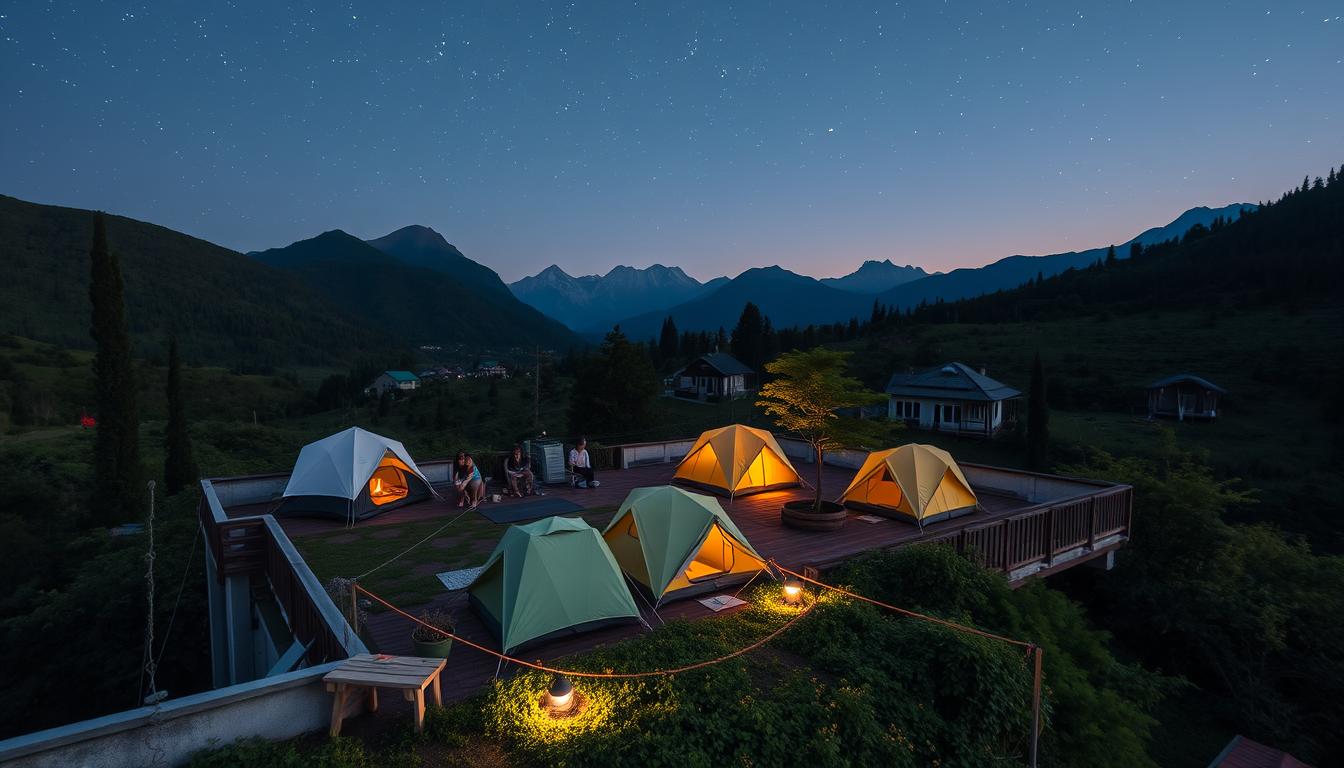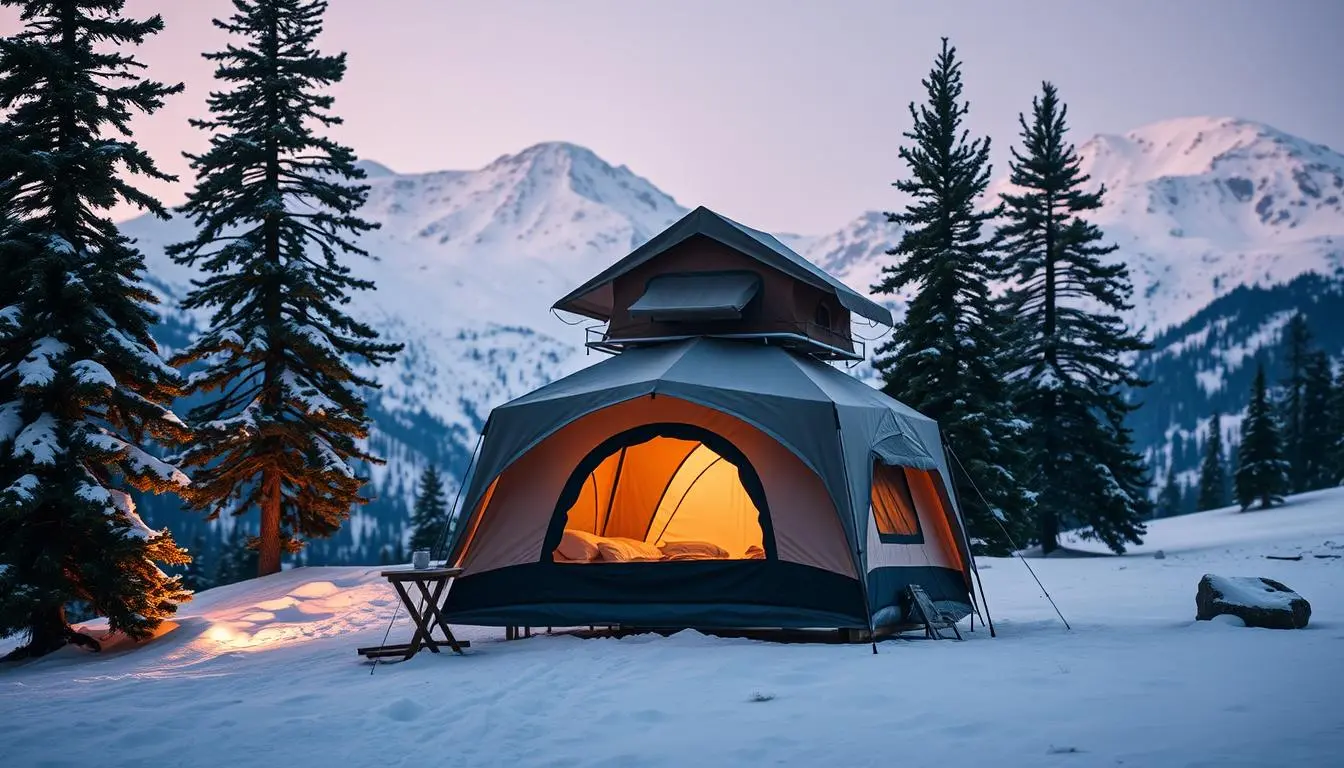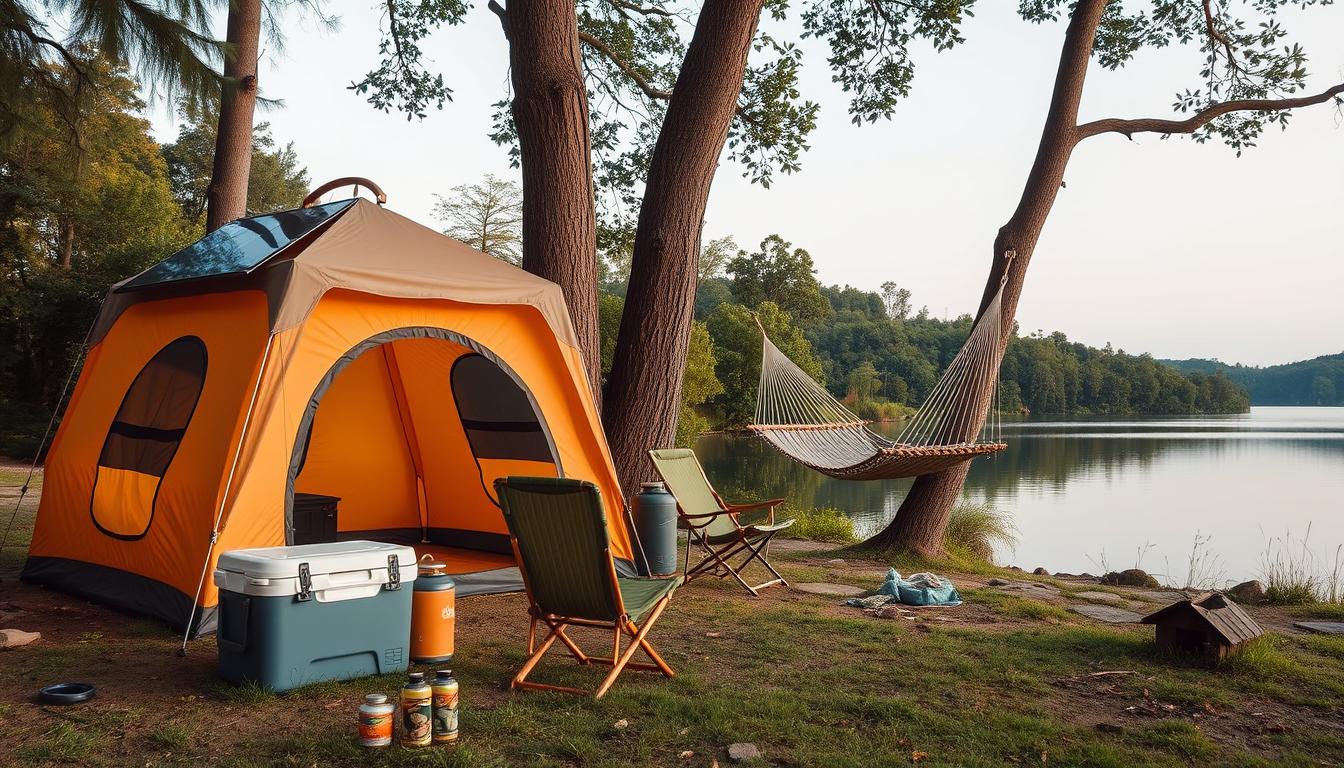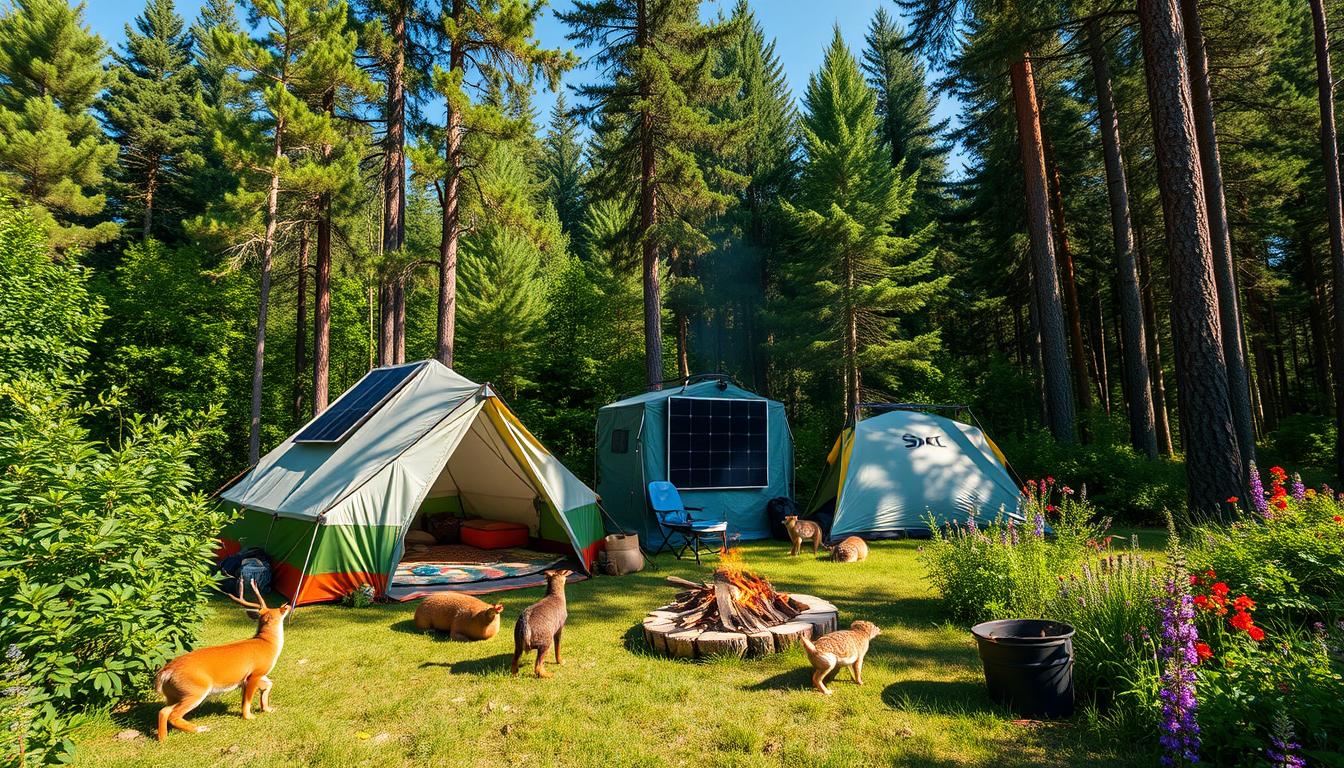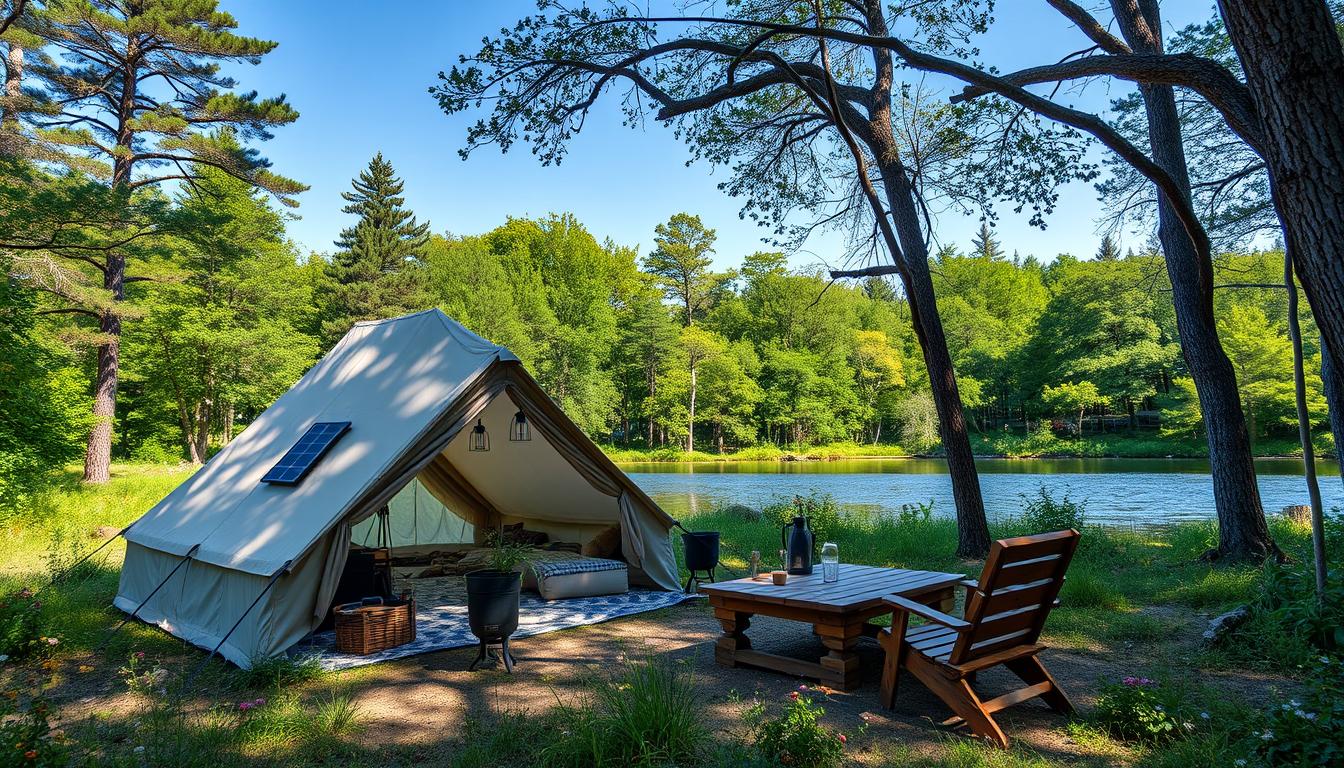According to a recent survey, over 70% of outdoor enthusiasts in the United States have expressed interest in trying rooftop camping, a unique and eco-friendly way to experience nature. This emerging trend highlights the growing desire among adventurers to find sustainable rooftop adventures that minimize their impact on delicate ecosystems, particularly in protected areas.
Responsible rooftop camping in protected areas requires a delicate balance between personal enjoyment and environmental preservation. In this article, we’ll explore the concept of rooftop camping, understand the importance of conserving protected areas, and learn about the best practices for engaging in this thrilling, yet eco-friendly, outdoor activity.
Key Takeaways
- Rooftop camping offers a unique and sustainable way to experience the great outdoors.
- Responsible camping practices are essential to protect the delicate ecosystems of protected areas.
- Understanding the purpose and types of protected areas is crucial for eco-friendly rooftop camping.
- Adhering to Leave No Trace principles and obtaining necessary permits ensures minimal impact on wildlife and natural habitats.
- Careful planning and preparation are key to ensuring a safe and responsible rooftop camping experience.
Understanding Rooftop Camping
Rooftop camping is an exciting and unique form of outdoor exploration that offers a refreshing twist on traditional camping. Unlike conventional ground-based camping, rooftop camping involves setting up a camp on the roof of a vehicle, such as a car, van, or RV. This distinctive approach allows adventurers to experience the great outdoors while enjoying the added benefits of mobility and elevated vantage points.
Definition and Concept
Rooftop camping, also known as car camping or vehicle-based camping, is the practice of setting up a tent, sleeping platform, or other camping gear on the roof of a vehicle. This unique camping style allows campers to access remote and protected areas while maintaining a comfortable and secure base of operations.
Benefits of Rooftop Camping
- Increased accessibility to remote and protected areas
- Elevated views and unique perspectives
- Reduced impact on sensitive ecosystems
- Increased mobility and flexibility during the camping experience
- Protection from the elements and potential wildlife encounters
Differences from Traditional Camping
While rooftop camping shares some similarities with traditional ground-based camping, there are several key differences that set it apart:
| Rooftop Camping | Traditional Camping |
|---|---|
| Elevated platform for camping | Ground-based camping |
| Increased mobility and accessibility | Limited to accessible campsites |
| Reduced impact on the environment | Potential for greater environmental impact |
| Unique perspectives and vantage points | Ground-level views |
By understanding the unique characteristics and benefits of rooftop camping, adventurers can make informed decisions about their outdoor exploration, ensuring they engage in responsible and sustainable practices when exploring protected areas.
Importance of Protected Areas
As avid rooftop enthusiasts, it’s crucial to understand the significance of protected areas and their role in conservation efforts. These natural sanctuaries are vital for preserving fragile ecosystems, safeguarding wildlife, and maintaining the delicate balance of our environment. Respecting the wilderness ethics for rooftoppers and practicing rooftop camping stewardship is essential when exploring these protected lands.
What Are Protected Areas?
Protected areas, such as national parks, wildlife refuges, and nature preserves, are designated regions where human activity is carefully managed to ensure the long-term preservation of the natural landscape, flora, and fauna. These areas are often recognized for their exceptional ecological, cultural, or scenic value, and they serve as sanctuaries for endangered species and fragile ecosystems.
Purpose of Conservation in Camping
The purpose of conservation in the context of camping is to minimize the impact of human activities on these protected environments. Rooftop campers must be mindful of the delicate balance of these ecosystems and strive to leave no trace, ensuring that their presence does not disrupt the natural order or compromise the habitats of the wildlife that call these areas home.
Types of Protected Areas
- National Parks: Expansive, federally-managed areas that showcase the country’s most breathtaking natural landscapes.
- Wildlife Refuges: Designated lands and waters set aside for the protection and management of specific wildlife species and their habitats.
- Nature Preserves: Privately or publicly owned areas that are managed to conserve the natural features and biodiversity of a particular ecosystem.
- Wilderness Areas: Undeveloped, pristine lands where the imprint of human activities is minimal, allowing for the preservation of natural processes.
Understanding the unique characteristics and purpose of these protected areas is essential for rooftop campers who wish to engage in responsible and sustainable outdoor adventures. By embracing the wilderness ethics for rooftoppers and practicing rooftop camping stewardship, we can ensure the longevity and preservation of these natural wonders for generations to come.
Responsible Camping Practices
When it comes to leave no trace camping and low-impact rooftop camping, responsible practices are essential to preserve the natural beauty and integrity of protected areas. By adhering to these principles, campers can minimize their footprint and ensure the long-term sustainability of the outdoor spaces they enjoy.
Leave No Trace Principles
The Leave No Trace principles serve as a guiding framework for responsible camping. These seven principles include:
- Plan Ahead and Prepare
- Travel and Camp on Durable Surfaces
- Dispose of Waste Properly
- Leave What You Find
- Minimize Campfire Impacts
- Respect Wildlife
- Be Considerate of Other Visitors
Permitting and Regulations
Before embarking on a rooftop camping adventure in a protected area, it’s crucial to familiarize yourself with the relevant permits and regulations. These requirements can vary depending on the specific location and may include obtaining permission from land management agencies, adhering to campsite restrictions, and following any additional guidelines.
Impact on Wildlife
The presence of campers in protected areas can have a significant impact on local wildlife. To minimize disturbances, it’s essential to keep a respectful distance from animals, avoid feeding them, and properly store food and trash to prevent attracting unwanted visitors. By being mindful of the delicate ecosystems, campers can help protect the natural habitats and the species that call them home.

By embracing responsible camping practices, rooftop campers can enjoy the beauty of protected areas while preserving them for future generations. Through a combination of leave no trace principles, compliance with regulations, and a deep respect for the environment, campers can leave a minimal impact and contribute to the long-term conservation of these precious outdoor spaces.
Choosing the Right Rooftop Location
When it comes to respecting nature while rooftopping, the selection of the right rooftop location is crucial. Sustainable rooftop adventures require careful evaluation of safety, accessibility, and environmental impact. By making responsible choices, adventurers can minimize their footprint and ensure a harmonious coexistence with the natural surroundings.
Evaluating Safety and Stability
The safety and stability of the rooftop are paramount considerations. Aspiring rooftop campers should thoroughly inspect the structural integrity of the site, checking for any potential hazards or compromised areas. Evaluating the load-bearing capacity of the roof is essential to ensure a stable and secure camping experience.
Accessibility Considerations
- Easy access to the rooftop, with clearly marked and well-maintained entry and exit points, is crucial for both convenience and emergency situations.
- Accessibility for all campers, including those with physical limitations, should be a priority to promote inclusive and sustainable rooftop adventures.
Assessing the Environmental Impact
Responsible rooftop campers must consider the environmental impact of their chosen location. Factors such as the presence of sensitive ecosystems, the risk of disrupting wildlife habitats, and the potential for erosion or soil degradation should all be carefully evaluated. By selecting sites with minimal ecological disruption, adventurers can ensure their rooftop experiences align with the principles of respecting nature while rooftopping.
Choosing the right rooftop location is a crucial step in creating sustainable rooftop adventures. By prioritizing safety, accessibility, and environmental considerations, rooftop campers can minimize their impact and enjoy their outdoor experiences in harmony with nature.
Essential Gear for Rooftop Camping
When embarking on eco-friendly rooftop camping adventures, having the right gear is crucial. From required camping equipment to safety essentials and eco-friendly alternatives, this section will guide you through the essential items to pack for your green rooftop adventures.
Required Camping Equipment
The foundation of any successful rooftop camping trip starts with the right camping gear. Invest in a sturdy, weatherproof tent, a comfortable sleeping bag, and a reliable camping stove. Don’t forget to pack essential cookware, utensils, and a water purification system to ensure you have all the necessities for your stay.
Safety Gear to Consider
Safety should be a top priority when camping on a rooftop. In addition to the standard camping gear, consider packing safety equipment such as a first-aid kit, a personal locator beacon, and a sturdy safety harness. These items can provide peace of mind and help you respond quickly in case of emergencies.
Eco-Friendly Options
When choosing your camping gear, look for eco-friendly and sustainable alternatives that minimize your environmental impact. Opt for biodegradable and reusable camping supplies, such as bamboo utensils, solar-powered lanterns, and eco-friendly water bottles. By making conscious choices, you can ensure your rooftop camping experience is as green as possible.
“The right gear can make all the difference in ensuring a safe and sustainable rooftop camping adventure.”
Preparing for your eco-friendly rooftop camping trip involves carefully selecting the right equipment. By prioritizing safety, sustainability, and comfort, you can create a memorable and responsible camping experience in protected areas.
Preparing for Rooftop Camping
Embarking on a responsible outdoor exploration or sustainable rooftop adventure requires thorough planning and preparation. As you get ready to experience the unique joys of rooftop camping in protected areas, consider these essential steps to ensure a safe and enjoyable journey.
Planning Your Trip
Careful trip planning is the foundation of a successful rooftop camping excursion. Begin by researching the protected area you intend to visit, familiarizing yourself with the regulations, permits, and any special considerations. Reach out to local authorities or conservation organizations to understand the specific requirements for rooftop camping in the region.
- Identify suitable rooftop camping locations that prioritize environmental preservation
- Obtain necessary permits and comply with all relevant regulations
- Coordinate with travel companions to align schedules and responsibilities
Weather Considerations
Closely monitoring weather conditions is crucial when planning a rooftop camping trip. Unpredictable weather can pose significant challenges, so it’s essential to stay informed and be prepared for various scenarios.
- Check long-range weather forecasts for the region and dates of your trip
- Pack appropriate gear, such as waterproof and windproof equipment, to adapt to changing weather
- Develop a contingency plan in case of severe weather events that may require altering your plans
Emergency Preparedness
Responsible outdoor exploration and sustainable rooftop adventures require a proactive approach to emergency preparedness. Equip yourself with the necessary skills and resources to handle unexpected situations and ensure the safety of yourself and your fellow campers.
- Familiarize yourself with first-aid procedures and pack a comprehensive medical kit
- Ensure reliable communication methods, such as satellite phones or emergency beacons, are accessible
- Develop an emergency action plan and share it with local authorities or trusted contacts

By meticulously planning your trip, staying vigilant about weather conditions, and prioritizing emergency preparedness, you’ll be well on your way to a safe and responsible rooftop camping experience in protected areas. Embracing these preparatory steps will help you fully immerse yourself in the natural wonders while minimizing your environmental impact.
Engaging with Local Communities
Responsible rooftop camping extends beyond just setting up camp in protected areas. It involves active engagement with the local communities that steward these natural spaces. By fostering meaningful connections, responsible outdoor exploration can create lasting positive impacts for both campers and the regions they visit.
Importance of Local Advocacy
Local advocacy is essential for preserving the integrity of protected areas. Campers can support community-led conservation efforts by lending their voices to initiatives that safeguard these vital natural resources. This might include attending town hall meetings, signing petitions, or collaborating with local organizations to amplify the importance of responsible camping practices.
Volunteering in Protected Areas
- Campers can make a tangible difference by volunteering within protected areas, such as participating in trail maintenance, habitat restoration, or wildlife monitoring programs.
- These hands-on experiences not only contribute to the stewardship of the land but also foster a deeper appreciation for the intricate ecosystems that thrive within protected spaces.
Learning from Indigenous Practices
Many protected areas have long been the ancestral lands of Indigenous communities. By learning from their time-honored sustainable practices, rooftop camping enthusiasts can gain valuable insights into responsible exploration and conservation. This exchange of knowledge can lead to more mindful camping experiences that respect the cultural heritage and traditional ecological wisdom of local populations.
| Community Engagement Approach | Potential Impact |
|---|---|
| Attending local town hall meetings | Amplifies the voice of campers in conservation efforts |
| Volunteering in protected areas | Contributes to hands-on stewardship and ecological restoration |
| Learning from Indigenous practices | Fosters a deeper respect for cultural heritage and traditional ecological knowledge |
By engaging with local communities, rooftop camping enthusiasts can play a vital role in the stewardship and preservation of protected areas, ensuring that these natural sanctuaries remain vibrant and accessible for generations to come.
Ecological Awareness in Camping
As rooftop campers, it’s crucial to develop a deep ecological awareness and understanding of the local environments we venture into. By immersing ourselves in the natural landscapes of protected areas, we can gain valuable insights into the intricate web of life that surrounds us.
Understanding Local Ecosystems
Rooftop camping provides a unique opportunity to observe and appreciate the delicate balance of local ecosystems. From the diverse flora and fauna to the intricate cycles of water, nutrients, and energy, every protected area harbors a wealth of ecological wonders waiting to be discovered.
Species Diversity and Conservation
Many protected areas are home to a rich tapestry of plant and animal species, some of which may be rare or endangered. As wilderness ethics for rooftoppers, we have a responsibility to learn about and respect the local biodiversity, ensuring our low-impact rooftop camping practices do not disrupt the fragile ecosystems we visit.
Minimizing Human Impact
Practicing environmental stewardship is paramount when rooftop camping in protected areas. This involves adhering to the principles of Leave No Trace, minimizing our waste, and being mindful of our interactions with the natural world. By adopting a reverent approach, we can ensure our presence has a minimal impact on the delicate balance of these precious landscapes.
| Ecological Considerations | Recommended Practices |
|---|---|
| Respecting local flora and fauna | Observe wildlife from a distance, avoid disturbing nesting sites, and tread lightly to preserve delicate plants and habitats. |
| Waste management | Pack out all trash, properly dispose of human waste, and use eco-friendly cleaning products to minimize environmental impact. |
| Minimizing disturbance | Keep noise levels low, avoid building large campfires, and choose campsites that are already established to prevent further habitat degradation. |
By cultivating a deep ecological awareness, rooftop campers can embark on their adventures with a profound respect for the natural world and a commitment to preserving the integrity of the protected areas they visit.
Social Responsibility While Camping
As responsible rooftop campers, it’s crucial to consider the social impact of our adventures in protected areas. These natural havens are not only environmentally significant but also deeply connected to the cultural heritage of local communities. By embracing a socially conscious approach, we can ensure that our green rooftop adventures leave a positive and lasting impression.
Respecting Cultural Heritage
When exploring protected areas, it’s essential to be mindful of the rich cultural traditions that have shaped these landscapes over generations. Take the time to learn about the indigenous communities, their customs, and their relationship with the land. Respect their sacred sites and avoid disrupting cultural practices during your stay.
Supporting Local Economies
As rooftop campers, we have the opportunity to positively impact local economies by supporting small businesses and artisans. Seek out locally sourced goods, dine at local restaurants, and engage with community-based tourism initiatives. This not only enriches your green rooftop adventure but also helps to sustain the livelihoods of those who call these protected areas home.
Educating Fellow Campers
One of the most impactful ways to practice social responsibility while rooftop camping is to share your knowledge and insights with fellow adventurers. Engage in conversations about the importance of conservation, the cultural significance of the area, and the best practices for minimizing your footprint. By fostering a sense of collective responsibility, we can inspire others to join us in our commitment to responsible camping in protected areas.
“When we tread lightly and leave no trace, we honor the land and its caretakers, ensuring that future generations can enjoy the same awe-inspiring experiences.”
Case Studies of Responsible Rooftop Camping
The responsible practice of sustainable rooftop adventures and eco-friendly rooftop camping is not just a theory – it’s a reality showcased through inspiring case studies and community involvement stories. These real-world examples shed light on the successful implementation of responsible camping initiatives, as well as the valuable lessons learned along the way.
Successful Programs and Initiatives
One remarkable example is the Rooftop Campsite Stewardship Program in Colorado, where a team of dedicated volunteers works with local authorities to maintain and protect designated rooftop camping sites. By following strict Leave No Trace principles, they ensure the delicate ecosystems of these protected areas remain undisturbed, while also educating fellow campers on sustainable practices.
Community Involvement Stories
In California, the Rooftop Camping Community Association has empowered local residents to take an active role in managing and monitoring rooftop camping sites. Through regular clean-ups, habitat restoration projects, and collaborative decision-making, this grassroots initiative has fostered a strong sense of stewardship and environmental responsibility among the camping community.
Lessons Learned from Experiences
The journey towards responsible rooftop camping has not been without its challenges, but the lessons learned from these experiences have been invaluable. For example, the importance of working closely with indigenous communities to understand and respect traditional land management practices has been a key takeaway, leading to more inclusive and culturally-sensitive camping policies.
These case studies and community-driven stories serve as a testament to the power of collective action in promoting sustainable rooftop adventures and eco-friendly rooftop camping in protected areas. By learning from these inspiring examples, we can collectively work towards a future where responsible camping practices are the norm, not the exception.
Future of Rooftop Camping in Protected Areas
As eco-tourism continues to gain momentum, the future of rooftop camping in protected areas looks increasingly promising. Travelers are seeking more immersive, sustainable experiences that allow them to connect with nature while minimizing their environmental impact. This shift in preferences presents exciting opportunities for responsible outdoor exploration and green rooftop adventures.
Trends in Eco-Tourism
The growing interest in eco-tourism has driven a surge in demand for unique, low-impact camping experiences, such as rooftop camping in protected areas. Travelers are becoming more conscious of their environmental footprint and are actively seeking out activities that align with their values of conservation and preservation. This trend is expected to continue, with protected areas playing a crucial role in meeting the evolving needs of eco-conscious campers.
Role of Technology in Camping
Technology is poised to play an increasingly important role in the future of rooftop camping. Innovations in portable, energy-efficient gear, GPS-enabled navigation, and real-time environmental monitoring can enhance the camping experience while promoting sustainable practices. From lightweight, solar-powered equipment to mobile apps that provide detailed information on local ecosystems, technological advancements are empowering campers to explore protected areas responsibly.
Sustainable Practices for the Future
As the demand for rooftop camping in protected areas grows, there is a strong emphasis on developing and implementing sustainable practices to ensure the long-term viability of these natural spaces. This includes implementing strict leave-no-trace principles, utilizing renewable energy sources, and working closely with local communities to minimize the impact on delicate ecosystems. By prioritizing sustainability, the future of rooftop camping can strike a harmonious balance between human exploration and environmental preservation.
